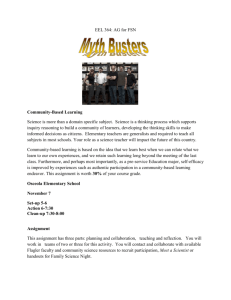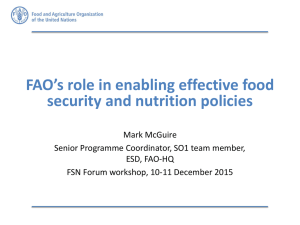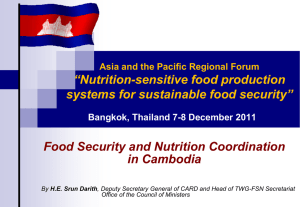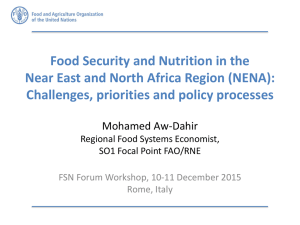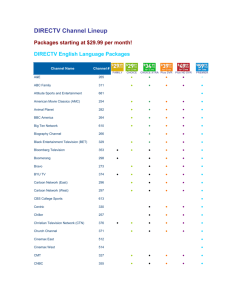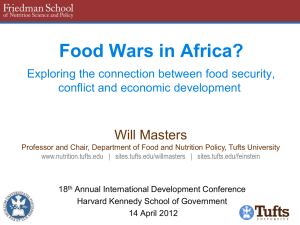SDG proposals for food security and nutrition: some
advertisement
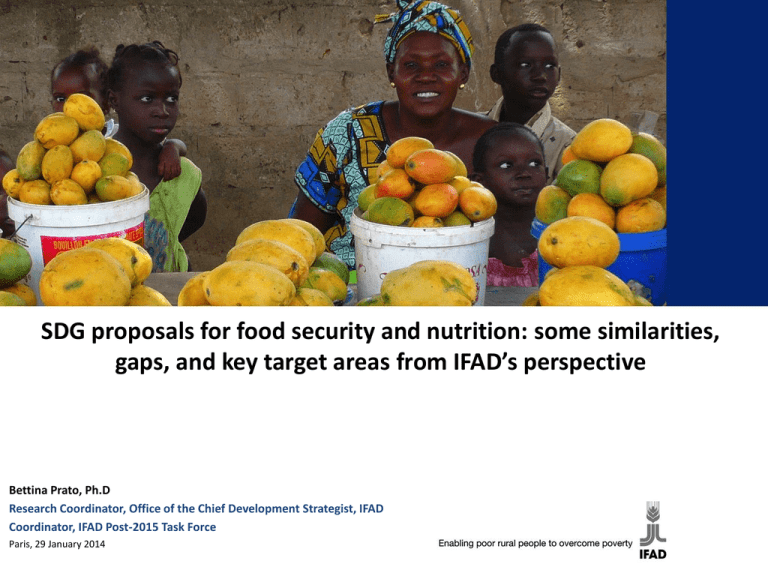
SDG proposals for food security and nutrition: some similarities, gaps, and key target areas from IFAD’s perspective Bettina Prato, Ph.D Research Coordinator, Office of the Chief Development Strategist, IFAD Coordinator, IFAD Post-2015 Task Force Paris, 29 January 2014 Some general considerations to begin with • FSN is quite prominent in current SDG debates • Hunger remains in focus as unfinished MDG business, closely linked to poverty • Nutrition and SA are “new” areas of concern, as agenda aims to be universal + sustainable • FSN-SA linkages are increasingly recognized... • ...but other key linkages less so – e.g. FSN and SA links to inclusive and sustainable growth • Yet, many food insecure people are small farmers, who need to be active contributors to FSN and to sustainable, inclusive growth • To achieve FSN, the SDGs should help create new opportunities for farmers and the rural sector to contribute to sustainable and inclusive growth Several SDG proposals broaden the focus of MDG 1, including nutrition and sustainable agriculture (SA) into FSN HLP Goal 5: Ensure food security and good nutrition. Targets for ending hunger/right to food; child malnutrition; ag productivity (esp. SH yields, irrigation); SA practices; reduction of losses and waste. SDSN Goal 1: End extreme poverty in all its forms, incl. hunger, child stunting, malnutrition, food insecurity (…). Goal 6: Improving ag systems and raising rural prosperity. Targets for food production, yields, efficient use of water, energy, soil nutrients, nutritious diets, losses/waste; land conversion, soil protection, resilience NB: Goal 6 has target on rural access to resources, infrastructure services GC Goal 5: Good nutrition for all through sustainable food + ag systems. Targets for hunger and malnutrition; stunting; productivity of LDC ag; GHG emissions and deforestation; fisheries; food losses and waste • Plus: full and equal access of women to property – including land titles Asia-Europe foundation: Goal on SA, FS and nutrition. Targets for access to affordable, nutritious, healthy food; productivity and SA; effective/equitable land use mgt; preservation of agro-ecosystems Alliancesud et al.: Goal on adequate, permanently available, sustainably produced food and nutrition for all. Targets for malnutrition; losses and waste; SH (esp. women) livelihoods, entitlements, and incomes; sustainable, diverse and resilient ag; inclusive governance UN approach also getting broader, striving to bridge the human, social, economic, and environmental sides of the FSN challenge • UN-SG Zero Hunger Challenge – comprehensive vision, bridging hunger, rural poverty, nutrition, and sustainability concerns • Joint RBA paper for Rio+20 recommends integrating into SD goals/targets the following issues: – – – – – – – – – Hunger and poverty eradication Progressive realization of the right to food Access to nutritious food for all Sustainable, climate-smart, resilient agriculture Social protection and safety nets Reducing losses, waste along food supply chain Fair and well-functioning ag and food markets Gender equality Multi-stakeholder, participatory governance (…) • RBA-led issue briefs to OWG – comprehensive approach linking FSN to SA, rural development, and inclusive governance of food systems How IFAD sees FSN and post-2015 against this background • Sustainable and inclusive rural development is a key entry point to address poverty, sustainability, inclusive growth, and FSN together • The SDGs can create new opportunities for the rural sector, by aligning international and domestic, public and private efforts through appropriate incentives and common SD objectives • 4 key target areas where the SDGs could prompt policy focus and investments for a transformative rural agenda: 1) 2) 3) 4) Inclusive and sustainable rural-urban integration Economic and social empowerment of poor rural women and men A thriving and nutrition-sensitive smallholder family agriculture sector Rural livelihood resilience, notably with respect to climate change • Precise targets and indicators can be formulated in all 4 areas depending on context specificities, fitting under different SDG areas Using FSN as an entry point to explore targets in these areas • IFAD-RBA workshop on FSN targets 9 Dec. ‘13, showing convergence of proposals around the ZHC areas. Indicative targets include: a) All have access to adequate food all year round b) Malnutrition in all its forms is ended or reduced by x%, stunting below age of 2 is ended c) All food production systems become more sustainable, resilient and efficient d) All small food producers, esp. women, have secure access to inputs, knowledge, productive resources and services to increase productivity, thereby enhancing their livelihoods and resilience e) More efficient post-production systems that halve global loss/waste NB – each of the targets, especially d) and e), is formulated to encourage policy and investments creating opportunities for small farmers and other poor rural people to be part of the solution to FSN, inclusive and sustainable growth, and SD in general Conclusions • Emerging narrative of FSN has clear environmental and nutrition elements enriching MDG1 scope • Gaps remain notably in recognizing linkages between FSN, SA and sustainable and inclusive (and more nutrition-sensitive!) growth • IFAD believes that MDG1 unfinished business requires enabling rural people – notably small farmers – and rural sectors to be fully part of a transformative agenda for growth, underpinning also FSN • A global SDG agenda can help align international and country-level, public and private efforts in this regard • However, this is a cross-cutting agenda, which goes beyond any individual goal and that requires great attention to inter-linkages Thank you!
